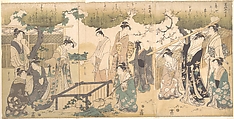At the Tsutsui Well
Chōbunsai Eishi Japanese
Not on view
The two left panels of this triptych depict the love of a young man and woman who were next-door neighbors and playmates during their childhood. The artist Eishi quotes their love poems from The Tales of Ise along the top of the composition. The man sent to his love:
By the barrel-well's
built-up crib I'd pull myself
measuring my height:
I've grown to be a man
this long while we've been apart.
The girl sent back:
Since we vied for height
my once childish hair has grown
beyond my shoulders:
If it is not to be you,
who then best should tie it up?
The print cleverly combines this story of lovers whose bond was to endure throughout their lives with a story related earlier in The Tales of Ise about an unfortunate young man who, after a year, reminisces about his lost love. The poem he recites upon returning to the now-deserted residence of his beloved is quoted at the top of the sheet on the right side of the triptych:
The moon: is it not . . .
the spring: is it not . . . last year's
spring yet unchanged? No,
this body of mine alone
seems the same as once before.
Although the text of The Tales of Ise makes no connection between these two nonsequential episodes, the illustration brings them together as if to comment that both are stories of love and the passage of time, though time strengthened love in one case and deepened its sadness in the other. This subtle interpretation, however, is represented in the form of a mitate, a humorous contemporary parody of a classical narrative: all the players are shown as beautiful Edo-period women in the lavish costume
of their own time.
Due to rights restrictions, this image cannot be enlarged, viewed at full screen, or downloaded.

